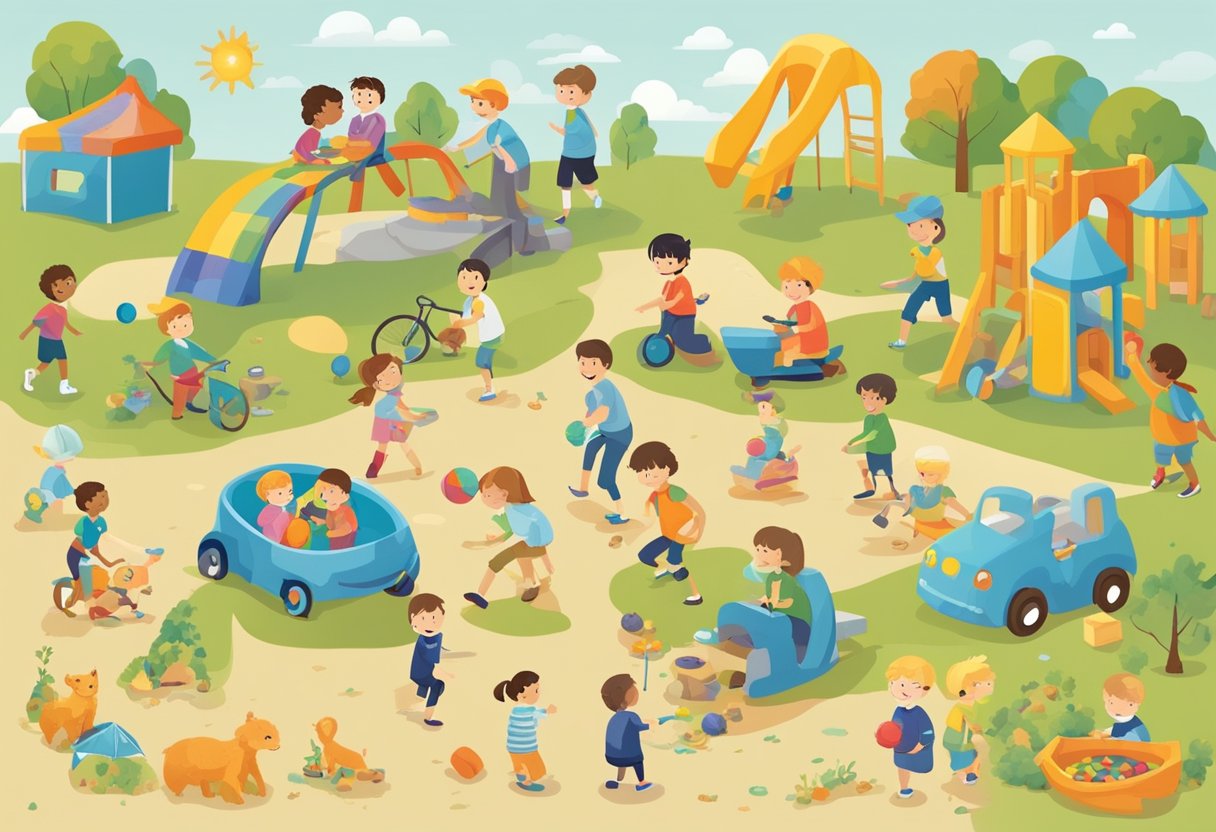Types Of Play
Play is an essential part of a child’s development that helps them learn and grow. It is a natural way for children to explore and understand the world around them. There are different types of play that children engage in, each with its own benefits and purposes.
Fundamentally, play is an activity that is enjoyable, voluntary, and spontaneous. It is an essential part of childhood and helps children develop social, emotional, cognitive, and physical skills. Play can be structured or unstructured, solitary or social, and can involve imagination, creativity, and problem-solving.
There are various types of play that children engage in, including physical, constructive, imaginative, and social play. Physical play involves activities that improve a child’s gross motor skills, such as running, jumping, and climbing. Constructive play involves activities that allow children to build, create, and manipulate objects, such as building blocks or puzzles. Imaginative play involves role-playing, make-believe, and fantasy, while social play involves interacting with others, such as playing games or participating in group activities.
Key Takeaways
- Play is an essential part of a child’s development that helps them learn and grow.
- There are different types of play that children engage in, each with its own benefits and purposes.
- Play can be structured or unstructured, solitary or social, and can involve imagination, creativity, and problem-solving.
Fundamentals of Play

Stages of Play
Play is an essential component of healthy development in children. There are various stages of play that children go through as they grow and develop. The first stage of play is unoccupied play, which typically occurs from birth to three months. During this stage, children do not engage in play as we typically think of it. Instead, they engage in random movements, such as kicking their legs or waving their arms.
The next stage of play is solitary play, which typically occurs from around six months to two years. During this stage, children play alone and do not interact with others. They may engage in activities such as stacking blocks or playing with toys.
Parallel play is the next stage of play, which typically occurs from around two to three years. During this stage, children play alongside each other but do not interact. They may engage in similar activities, but they do not share or communicate with each other.
The next stage of play is associative play, which typically occurs from around three to four years. During this stage, children begin to interact with each other and share toys and materials. They may engage in activities such as playing dress-up or building with blocks.
The final stage of play is cooperative play, which typically occurs from around four years and up. During this stage, children engage in play with a common goal and work together to achieve it. They may engage in activities such as playing games or building a fort together.
Developmental Importance
Play is crucial for healthy development in children. It allows children to develop their social, emotional, cognitive, and physical skills. Through play, children learn how to interact with others, solve problems, and express themselves creatively.
Research has shown that play is essential for brain development and that children who engage in play have better academic outcomes and a higher likelihood of success in life. Play also promotes physical development, as children engage in activities that help to develop their motor skills and coordination.
Parents and caregivers should encourage play in children and provide them with opportunities to engage in different types of play. This can include providing them with toys and materials that promote creativity and imagination, as well as engaging in play with them and providing them with opportunities to interact with other children.
Types of Play
Play is an essential aspect of a child’s development as it provides opportunities for them to learn, grow, and explore the world around them. There are several types of play, each with its unique benefits and characteristics. In this section, we will explore four main types of play: Physical Play, Social Play, Creative Play, and Cognitive Play.
Physical Play
Physical play is any play that involves physical activity, such as running, jumping, climbing, or playing sports. This type of play is crucial for children’s physical development as it helps them develop gross motor skills, coordination, balance, and strength. Physical play also promotes an active lifestyle, which is essential for maintaining good health.
Social Play
Social play is any play that involves interaction with other children. This type of play helps children develop social skills, such as communication, cooperation, and teamwork. Social play also teaches children how to take turns, share, and negotiate, which are essential life skills. Examples of social play include board games, role-playing, and playing with dolls or action figures.
Creative Play
Creative play is any play that involves imagination and creativity, such as drawing, painting, storytelling, or building with blocks. This type of play helps children develop creative thinking skills, which are essential for problem-solving and innovation. Creative play also encourages children to express themselves and their emotions, which is crucial for their emotional development.
Cognitive Play
Cognitive play is any play that involves thinking and problem-solving, such as puzzles, memory games, or strategy games. This type of play helps children develop cognitive skills, such as memory, attention, and reasoning. Cognitive play also promotes learning and academic achievement, which is crucial for success in school and beyond.
Overall, each type of play offers unique benefits for children’s development. By providing children with opportunities for physical, social, creative, and cognitive play, parents and caregivers can help them reach their full potential.
Play and Learning
Play is not just about having fun, it is also a crucial component of a child’s learning and development. Through play, children can learn a variety of skills, including problem-solving, creativity, and socialization. In this section, we will explore how play can be used as a tool for learning and the role of adults in facilitating this process.
Educational Toys
Educational toys are designed to promote learning through play. These toys can be anything from play kitchens to blocks, puzzles, and board games. They are designed to be both fun and educational, allowing children to learn while they play.
One of the benefits of educational toys is that they can help children develop a range of skills. For example, playing with blocks can help children develop spatial awareness and problem-solving skills, while board games can help children develop their social skills and strategic thinking.
Role of Adults in Play
While children can learn a lot through play on their own, adults can play an important role in facilitating this process. Adults can help children by providing them with opportunities to play, setting up activities that promote learning, and guiding children through the play process.
Adults can also help children learn by asking questions and encouraging them to think critically about what they are doing. For example, if a child is playing with blocks, an adult might ask them to think about how they can use the blocks to build a tower or a bridge.
In conclusion, play is an essential component of a child’s learning and development. Through play, children can learn a range of skills that will be valuable throughout their lives. By providing children with educational toys and guiding them through the play process, adults can help children get the most out of their playtime.
Social and Emotional Development
Children’s social and emotional development is critical to their overall growth and well-being. Play is a powerful tool for developing these skills and helping children build relationships, communicate effectively, and develop empathy.
Building Relationships
Through play, children learn how to interact with others, make friends, and build relationships. They learn how to share, take turns, and communicate their needs and feelings in a way that is respectful and kind. Play also helps children develop important socialization skills, such as cooperation, negotiation, and conflict resolution.
Emotional Skills and Empathy
Play also helps children develop important emotional skills, such as self-awareness, self-regulation, and empathy. When children engage in imaginative play, they learn how to understand and express their own emotions, as well as recognize and respond to the emotions of others. This helps them develop empathy, which is an essential component of healthy relationships and socialization.
Research has shown that play is essential for children’s social and emotional development. According to a study published in the American Journal of Play, “play is essential to the development of social and emotional skills, as well as cognitive and physical development.” Therefore, parents and caregivers should encourage children to engage in a variety of play activities that promote social and emotional development. This can include imaginative play, games that require teamwork, and activities that involve sharing and cooperation.
In conclusion, play is a powerful tool for promoting children’s social and emotional development. By engaging in a variety of play activities, children can learn important skills such as communication, empathy, and cooperation, which will serve them well throughout their lives.
Play Structures and Contexts
Structured vs. Unstructured Play
Play can be structured or unstructured, and both types of play are important for a child’s development. Structured play refers to activities that have a set of rules or guidelines to follow. This type of play often involves an adult or teacher directing the activity and can include games, sports, and organized activities. Structured play can help children learn important skills such as following rules, taking turns, and working together.
On the other hand, unstructured play, also known as free play, allows children to explore and create in an open-ended environment without any specific rules or guidelines. This type of play can include activities such as imaginative play, playing with toys, and exploring the outdoors. Unstructured play allows children to develop their creativity, problem-solving skills, and independence.
Solo and Group Dynamics
Play can also be categorized as solitary or group play. Solitary play refers to play that a child engages in alone, without any interaction with other children. This type of play can include activities such as drawing, reading, or playing with toys. Solitary play can help children develop their imagination and creativity, as well as their ability to focus and concentrate.
Group play, on the other hand, involves two or more children playing together. Group play can be further categorized into parallel play, cooperative play, and competitive play. Parallel play refers to children playing alongside each other without any interaction. Cooperative play involves children working together towards a common goal or activity. Competitive play involves children competing against each other in games or activities.
In conclusion, different types of play structures and contexts can provide unique benefits to a child’s development. It is important for children to have opportunities to engage in both structured and unstructured play, as well as solitary and group play. By providing children with a variety of play experiences, parents and caregivers can help promote their overall development and well-being.






